View in other NatureServe Network Field Guides
NatureServe
Montana
Utah
Wyoming
Idaho
Wisconsin
British Columbia
South Carolina
Yukon
California
New York
Whitetop - Lepidium draba
Other Names:
Heart-pod Hoarycress,
Cardaria draba
State Rank Reason (see State Rank above)
Lepidium draba is a plant native to the Balkan Peninsula, Armenia, Turkey, Israel, Syria, Iraq, and Iran and has been introduced into each continent except Antarctica (Graves-Medley and Mangold 2011). A conservation status rank is not applicable (SNA) because the plant is an exotic (non-native) in Montana that is not a suitable target for conservation activities.
NOTE: There is a large discrepancy between the number of observations and counties represented in the herbaria (Consortium of Pacific Northwest Herbaria; www.pnwherbaria.org) versus the Montana Natural Heritage Program databases, which indicates a problem. It is important to document new occurrences with nice quality plant specimens of which some should be deposited in our State herbaria (University of Montana, Montana State University, Montana State University-Billings). Depositing specimens in the herbaria allows identifications to be confirmed, provides a central location for educating and sharing information, and allows specimens to be studied for genetics, morphology, and ecology.
General Description
PLANTS: Perennial, rhizomatous forbs that grow 20 to 50 cm tall. Stems are single, branching above the ground and at their base grow either erect or decumbent. Sources: FNA 2010; Lesica et al. 2012
LEAVES: Basal leaves (rosette) are grayish-green and gradually narrow to a petiole that connects to the root crown. Basal leaves whither early. Stem leaves are alternately arranged, grayish-green, arrowhead-shaped, clasp the stem, and have entire to unevenly toothed margins. Leaf surfaces may be without hairs (glabrous) or with soft white hairs (pubescent). Sources: FNA 2010; Lesica et al. 2012
INFLORESCENCE: White flowers are arranged in flat-topped racemes (corymbose). As fruits mature the stem of the raceme may elongate, thus losing it's flat-topped appearance. Flowers have 4 white petals of 2.5-4.5 mm long, 4 greenish-white sepals of 1.5–2.5 mm long, stamens 6 (4 long and 2 short), and 1 pistil. Sources: FNA 2010; Lesica et al. 2012
Phenology
Flowering April to August (FNA 2010).
Diagnostic Characteristics
Botanists A. Thellung (1906), C.L. Hitchcock (1936), and C. Linnaeus correctly placed
Lepidium draba into the genus
Lepidium, which is now supported on phylogenetic and taxonomic grounds (FNA 2010). Further,
Lepidium appelianum, Lepidium chalepense, and
Lepidium campestre are also correctly placed (FNA 2010). However, the placement of these species into the genus
Cardaria does not make sense from both phylogenetic and taxonomic grounds (FNA 2010).
There are many white-flowered species in the Mustard Family, both native and exotic. It is recommended that identifications be made using a plant manual designed for Montana. Mustards have flowers with 4 sepals, 4 petals, and 6 stamens (4 long and 2 short) among other characteristics.
Whitetop –
Lepidium draba, exotic and Noxious:
* White-flowered plants that grow from creeping roots (rhizomes) and have mature silicles (fruits) that are not notched at their tip.
* Silicles are glabrous (lack hairs), flattened, and their base is cordate (heart-shaped or indented). Silicles are tipped with a style of 1-1.5 mm long. Silicle stems (pedicels) are 5-12 mm long.
* Stem leaves are auriculate (lobed like an arrow) and clasping around the stem.
Globe-podded Whitetop –
Lepidium appelianum, exotic:
* White-flowered plants that grow from creeping roots (rhizomes) and have mature silicles (fruits) that are not notched at their tip.
* Silicles are pubescent (have hairs), inflated (globe-shaped), and with a short style of 0.4-1.0 mm long. Silicle stems (pedicels) are 4-11 mm long.
* Stem leaves are auriculate (lobed like an arrow) and clasping around the stem.
Perennial Pepperweed –
Lepidium latifolium, exotic and Noxious:
* White-flowered plants that grow from creeping roots (rhizomes) and have mature silicles (fruits) that are not notched at their tip.
* Silicles are glabrous or sparsely pilose (long soft hairs) with a very short style of 0.1 mm long or less. Silicle stems (pedicels) are 2-5 mm long.
* Stem leaves are sessile, but do not clasp around the stem.
Lenspod Whitetop –
Lepidium chalepense, exotic:
* White-flowered plants that grow from creeping roots (rhizomes) and have mature silicles (fruits) that are not notched at their tip.
* Silicles are glabrous (lack hairs), partially inflated and round (compressed-globose), not cordate (is pointed to its stem), and topped with a style 1-2 mm long. Silicle stems (pedicels) are 8-15 mm long.
* Stem leaves are auriculate (lobed like an arrow) and clasping around the stem.
The other Montana
Lepidium species (using MTNHP preferred name) have mature silicles with a notch of at least 0.1 mm deep at their top
and are not rhizomatous.
Hoary False-alyssum –
Berteroa incana, exotic and Noxious:
* White-flowered, annual plants that grow from taproots and have mature silicles (fruits) that are not notched at their tip.
* Each of the 4 petals are notched, making the flower appear 8-petaled.
* Plants have star-shaped hairs; whereas,
Lepidium species have simple hairs or none.
* Stem leaves are widest near their tip (oblanceolate), sessile on the stem, and point upwards.
Field Pennycress –
Thlaspi arvense, exotic:
* Easily differentiated if in fruit and easily confused with other species if only of leaves.
* White-flowered, annual plants that grow from taproots and have mature silicles (fruits) that are large, deeply notched at their tip, flat, and with wide wings, resembling a penny.
* Lower stem leaves have petioles. Upper stem leaves are sessile, clasping, auriculate (lobed like an arrow), and with smooth to toothed margins.
Common Yarrow –
Achillea millifolium, native and desirable:
* Member of the Aster/Sunflower Family.
* Bright-white flowers arranged closely in a flat-topped inflorescence.
* Leaves are 2-3 times pinnately dissected, appearing fern-like or bushy like a squirrel’s tail.
Sources: Jacobs and Mangold 2007; FNA 2010; Graves-Medley and Mangold 2011; Lesica et al. 2012.
Species Range
Montana Range
Range Descriptions
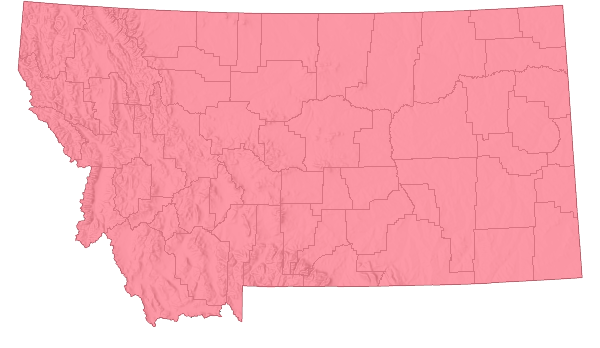
 Non-native
Non-native
Range Comments
Native to the Balkan Peninsula, Armenia, Turkey, Israel, Syria, Iraq, and Iran and has been introduced into each continent except probably not Antarctica (Graves-Medley and Mangold 2011). It likely came to North America in contaminated alfalfa seed (Sheley and Stivers in Sheley and Petroff 1999).
In Montana it was first documented in 1916 in Gallatin County (Consortium of Pacific Northwest Herbaria; http://www.pnwherbaria.org). In 1918 it was documented in Cascade County and upon determining the species it was noted on the herbarium specimen to be “a bad weed” (Consortium of Pacific Northwest Herbaria; http://www.pnwherbaria.org). Herbarium specimens document it in many counties (www.pnwherbaria.org), but newer observations are finding it in many more counties throughout Montana [Refer to sections, State Rank Reason and Observations In Montana Natural Heritage Program Database].
Adhikari et al. (2020) modeled the predicted future distribution of this and other weed species across the major road network in Montana under predicted future climate scenarios and found that area of predicted future habitat suitability is likely to decrease.
For maps and other distributional information on non-native species see:
Nonindigenous Aquatic Species Database from the U.S. Geological Survey
Invasive Species Habitat Tool (INHABIT) from the U.S. Geological Survey
Invasive Species Compendium from the Centre for Agriculture and Bioscience International (CABI)
EDDMapS Species Information EDDMapS Species Information
Observations in Montana Natural Heritage Program Database
Number of Observations: 9029
(Click on the following maps and charts to see full sized version)
Map Help and Descriptions
Relative Density
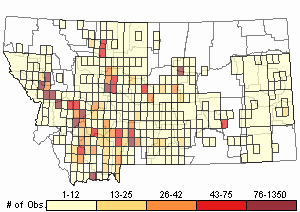
Recency
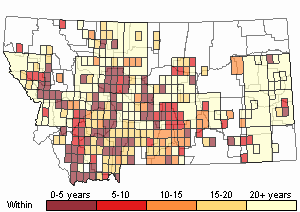

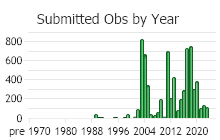
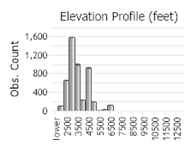 (Observations spanning multiple months or years are excluded from time charts)
(Observations spanning multiple months or years are excluded from time charts)
Habitat
Whitetop is best adapted to moderately moist sites where annual precipitation ranges from 12-16 inches and to alkaline soils that can stay moist into late spring (Graves-Medley and Mangold 2011). In Montana Whitetop is most abundant in irrigated fields with saline soil and roadsides in the valleys (Lesica et al. 2012). Whitetop grows best in open, unshaded sites.
Ecology
Habitat that is most susceptible to Whitetop invasion includes sub-irrigated pastures, mesic rangeland, ditch banks, roadsides, and waste areas, however arid rangelands are likely not susceptible (Graves-Medley and Mangold 2011). Whitetop is a problem in stubble and fallow fields, Conservation reserve Program (CRP) lands, and in irrigated croplands for small grains, alfalfa, peas, onions, sugar beets, and others. In the 1960’s Whitetop was found to associate where there is Smooth Brome (Bromus inermis), Russian Knapweed (Centaurea repens), aster (Symphyotrichum ericoides), Common Yarrow (Achillea millifolium), Fringed Sagebrush (Artemisia frigida), rose (Rosa spp.), and Common Snowberry (Symphoricarpos albus) (Selleck 1964).
Plants are dispersed by their seeds and creeping rhizomes. Seed are spread by wind, in water (streams and irrigation systems), by vehicles and machinery, and in hay and crop seed (Graves-Medley and Mangold 2011). Shoots develop from buds at or just above the point where lateral roots grow downward and become vertical; although, buds can develop on other portions of the root (Graves-Medley and Mangold 2011). An experiment found that whitetop (Lepidium spp.) plants can produce about 450 shoots in one year if growing without competition (Graves-Medley and Mangold 2011). With competition the plants rarely produced more than 50 shoots per square yard.
Reproductive Characteristics
Plants reproduce by seed and rhizomes (Graves-Medley and Mangold 2011).
FRUITS [Sources: FNA 2010; Lesica et al. 2012]
Pod-like fruits are silicles that ascend from branches. Silicles are flattened, broader near their base, 2–4 mm long, not notched at their tip, sparsely covered with long soft hairs (pilose), and glabrous. The tip of the fruit retains a short style, 1-1.5 mm long. The flower/silicle stem (pedicel) is 5-12 mm long, glabrous.
LIFE CYCLE [Adapted from Graves-Medley and Mangold 2011]
Seeds germinate in the fall and establish as seedlings. Within three weeks, leaves and lateral roots develop. Plants overwinter as rosettes. In early spring Whitetop rosettes initiate growth. In the spring, often from April to May, plants begin to flower. Seeds develop by around June. After blooming, plants continue to grow under good conditions, and can produce a second seed crop in late summer, until killed by frost.
Management
Successful control requires integrating strategies to prevent new, eradicate or containing existing, and controlling large populations.
PREVENTION [Adapted from Graves-Medley and Mangold 2011]
Seed development must be prevented to reduce or stop spread. Spread can be reduced by:
* Preventing vehicles from driving through and animals from grazing within infested areas,
* Thoroughly washing the undercarriage of vehicles that have travel through infested areas,
* Encouraging landowners to frequently monitor their land for new infestations and, when found to implement effective control methods.
* Maintain proper livestock grazing management that is more resilient to Whitetop invasion, and
* Developing educational campaigns to teach people to not pick and transport the white flowers.
PHYSICAL and CULTURAL CONTROLS [Adapted from Graves-Medley and Mangold 2011]
Hand-pulling can provide control to small or new populations and around homesteads, gardens, and other urban areas. Plants must be pulled within 10 days of emerging and repeated (if re-emerged) throughout the growing season for another 2-4 years to ensure it is eliminated from the site. Plants grow fast and preventing them from seeding is key to controlling the population. Rhizomes must also be fully removed or they will re-sprout. Weeding is more successful if done when soil is moist.
Tilling must be done within 10 days of emergence and repeated throughout the growing season for 2-4 years to exhaust reserves in the rhizomes.
Revegetation that establishes a desirable perennial plant community will compete best against Whitetop. Crop plants that are competitive include alfalfa and legumes.
Flooding can control Whitetop, particularly where soil textures are heavy and hold onto water with little seepage and/or where continuous submersion from May through September could occur. Flooding is more appropriate for riparian areas and places that naturally exhibit intermittent or ephemeral flooding. Flooding may be inappropriate in many habitats and could damage native or other desirable plants.
CHEMICAL CONTROLS [Adapted from Jacobs and Mangold 2007]
Herbicides can control Whitetop, but require an aggressive re-application program and should be part of an integrated weed management plan. The herbicide type and concentration, application time and method, environmental constraints, land use practices, local regulations, and other factors will determine its effectiveness and impact to non-target species. Strict adherence to application requirements defined on the herbicide label will reduce risks to human and environmental health. Consult your County Extension Agent and/or Weed District for information on herbicidal control. Chemical information is also available at
Greenbook.
These herbicides have been used on rangeland, roadsides, and waste areas and applied to actively growing rosettes in the early spring, to re-growth before flower buds develop, or to fall re-growth before frosts kill plants. Herbides should be applied with adequate water (at least 10 gallons per acre) and with a nonionic surfactant at the label rate:
*
Metsulfuron at the 0.5-1.0 ounce per acre rate,
* mixed
Metsulfuron and
Chlorsulfuron at the 2.0 ounce per acre rate, or
*
Chlorsulfuron at the 0.5-1.0 ounce per acre rate.
2,4-D has been somewhat effective is applied before the flower-bud stage. at the rate of 2 quarts per acre will kill stems, but not the root crowns. Root crowns will re-sprout and require a different follow-up treatment.
GRAZING CONTROLS [Adapted from Jacobs and Mangold 2007]
Livestock should not graze infested areas during flowering and seed-set periods. Animals that have grazed in areas with Whitetop should be contained and fed weed-free forage for 10-14 days before moving into weed-free areas. This provides the necessary time for seeds to bedigested and excreted.
BIOLOGICAL CONTROLSSeveral insects are being tested for use a biological control agent, but it is difficult since Whitetop is a member of the mustard family, which includes numerous important crops (cabbages, broccoli, mustard, canola, and others). Insects being investigated include a gall-forming weevil (
Ceutorhynchus cardariae), a seed-feeding weevil (
Ceutorhynchus turbatus), a root-mining weevil (
Melanobaris semistriata), a shoot mining flea beetle (
Psylliodes wrasei), and a gall mite (
Aceria drabae).
Useful Links:Central and Eastern Montana Invasive Species TeamMontana Invasive Species websiteMontana Biological Weed Control Coordination ProjectMontana Department of Agriculture - Noxious WeedsMontana Weed Control AssociationMontana Weed Control Association Contacts WebpageMontana Fish, Wildlife, and Parks - Noxious WeedsMontana State University Integrated Pest Management ExtensionWeed Publications at Montana State University Extension - MontGuidesStewardship Responsibility
References
- Literature Cited AboveLegend:
 View Online Publication
View Online Publication Adhikari, A., L.J. Rew, K.P. Mainali, S. Adhikari, and B.D. Maxwell. 2020. Future distribution of invasive weed species across the major road network in the state of Montana, USA. Regional Environmental Change 20(60):1-14. https://doi.org/10.1007/s10113-020-01647-0
Adhikari, A., L.J. Rew, K.P. Mainali, S. Adhikari, and B.D. Maxwell. 2020. Future distribution of invasive weed species across the major road network in the state of Montana, USA. Regional Environmental Change 20(60):1-14. https://doi.org/10.1007/s10113-020-01647-0 Lesica, P., M.T. Lavin, and P.F. Stickney. 2012. Manual of Montana Vascular Plants. Fort Worth, TX: BRIT Press. viii + 771 p.
Lesica, P., M.T. Lavin, and P.F. Stickney. 2012. Manual of Montana Vascular Plants. Fort Worth, TX: BRIT Press. viii + 771 p.
- Additional ReferencesLegend:
 View Online Publication
View Online Publication
Do you know of a citation we're missing? Guenther, G.E. 1989. Ecological relationships of bitterbrush communities on the Mount Haggin Wildlife Management Area. M.Sc. Thesis. Bozeman, MT: Montana State University. 73 p.
Guenther, G.E. 1989. Ecological relationships of bitterbrush communities on the Mount Haggin Wildlife Management Area. M.Sc. Thesis. Bozeman, MT: Montana State University. 73 p. Lesica, P., M.T. Lavin, and P.F. Stickney. 2022. Manual of Montana Vascular Plants, Second Edition. Fort Worth, TX: BRIT Press. viii + 779 p.
Lesica, P., M.T. Lavin, and P.F. Stickney. 2022. Manual of Montana Vascular Plants, Second Edition. Fort Worth, TX: BRIT Press. viii + 779 p. Seipel, T.F. 2006. Plant species diversity in the sagebrush steppe of Montana. M.Sc. Thesis. Bozeman, MT: Montana State University. 87 p.
Seipel, T.F. 2006. Plant species diversity in the sagebrush steppe of Montana. M.Sc. Thesis. Bozeman, MT: Montana State University. 87 p.
- Web Search Engines for Articles on "Whitetop"





